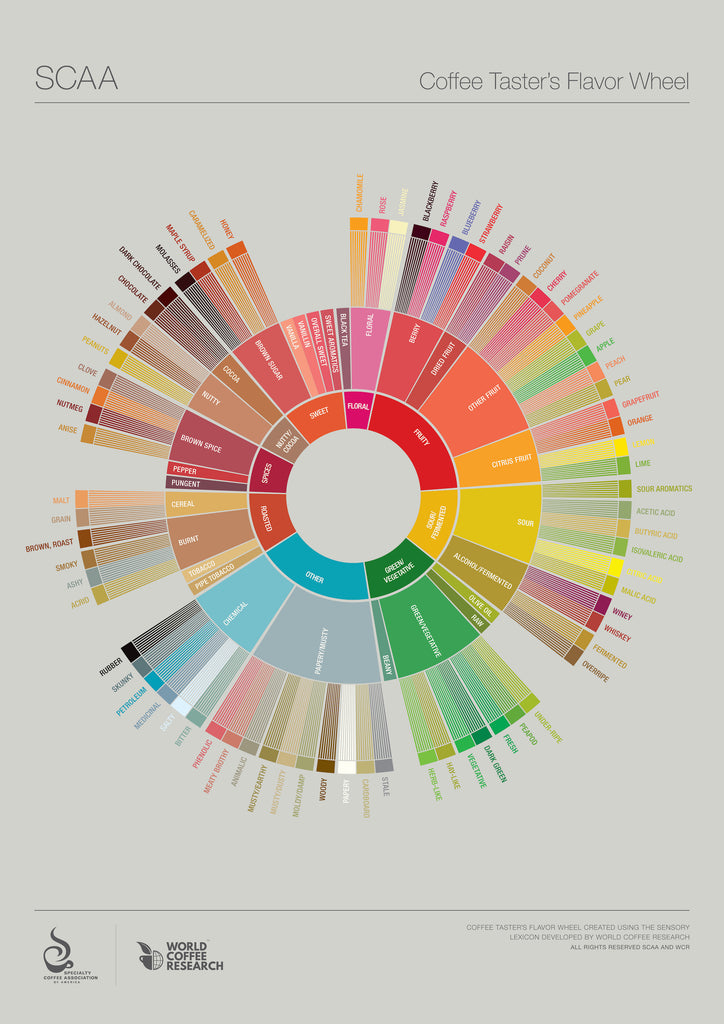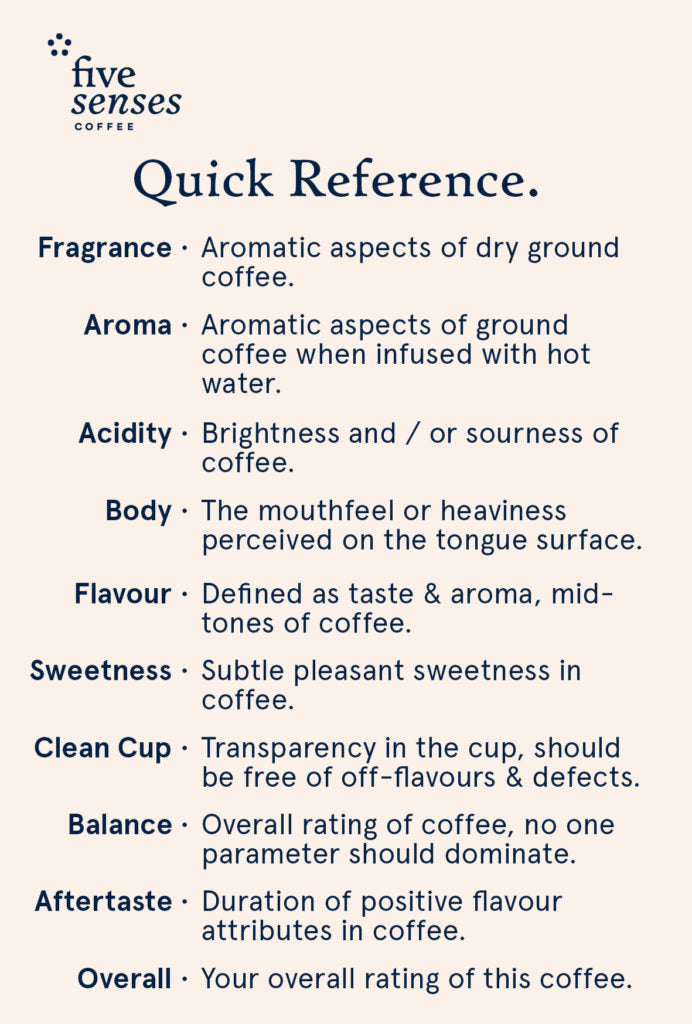Think back to your last incredible coffee experience. What did the coffee taste like? Can you describe it in enough detail to help a friend find it? Do the coffees you enjoy all have similar attributes?
 The answers to these questions will be influenced by your personal biases, experience and command of descriptive language. And when we’re talking about a global beverage which is consumed, described and traded in a multitude of countries and languages, that’s quite a range! However, despite these diverse contexts, there are some common bonds and shared science which can help guide our coffee discussions.
The answers to these questions will be influenced by your personal biases, experience and command of descriptive language. And when we’re talking about a global beverage which is consumed, described and traded in a multitude of countries and languages, that’s quite a range! However, despite these diverse contexts, there are some common bonds and shared science which can help guide our coffee discussions.
In January, we kicked off our curated cupping series for 2017 with ‘Quantifying Delicious’, an exploration of how the industry scores and reports on coffee throughout the supply chain. The approach to this assessment is driven by varying goals – describing qualities, determining value and, in some cases, attempting to mitigate some of our own personal biases in the process. In this article, we want to unpack some of the more widely utilised processes, language and standards used to talk about coffee.
Regardless of where you are on your coffee journey, understanding some of the mechanics and science behind taste and flavour perception can provide a strong foundation for improving your coffee experience.

Source: Wikipedia
Taste vs. Flavour
Taste and flavour are often confused with one another, so let’s break it down a little.
Taste: One of our five senses, taste is perceived by receptor cells called papillae which are located predominantly on your tongue and the roof of your mouth. We are all born with varying quantities of papillae (commonly known as taste buds) and the more you have, the more sensitive you are likely to be to the five elements of taste perception: sweet, sour, salty, bitter and umami (savoury). As we’ll discuss below, with regard to coffee tasting, more papillae doesn’t always mean better.
Flavour: Flavour combines not only gustation (taste) but a combination of multiple olfactory (smell), tactile and thermal sensations. Our perception of coffee flavour is the combined input of these impressions into one holistic experience.
 So, what makes a great coffee taster?
So, what makes a great coffee taster?
There are three categories of taster, defined by the number of taste buds found in roughly a 5mm diameter circle on the tongue. The distribution of these categories follows a pretty standard bell curve. Non-tasters (roughly 25% of the population) are dealt a lower-than-norm number of papillae of less than 15 in the given space. Average-tasters (the large majority, about 50% of people) generally have between 15 and 30 papillae, while super-tasters (about 25% of the population) are those with more than 30 taste buds in that 5mm circle on the tongue. It’s a pretty fascinating test and you can find out more at Wine Folly – Are You a Super Taster?.
At this point, I can see all the coffee pros assuming the stance of ‘super-taster’ and getting their strut on, while the presumed non-tasters amongst us are curling into a foetal position, second guessing the very fabric of their being. But wait!
As mentioned previously, more taste buds do not necessarily make a better coffee taster make. Human physiology is built to respond to many organic acids and especially bitterness, as it can be an indicator of poison. Many of the more sensitive tasters (and babies whose ‘taste response’ is still forming) will perceive these attributes in a very negative way, while average-tasters can find aspects of bitterness (think hoppy IPA beers) and acidity (think lemon juice) pleasing experiences. Non-tasters are both blessed and cursed in that they won’t get as offended by these characteristics, but their spectrum of taste sensations is equally muted.
As we identified previously, taste sensations don’t make up the full flavour picture. How well each of us perceive aroma, mouthfeel and temperature will all play into our combined experience of the coffee in front of us. These objective sensory inputs will impact how you think and talk about your coffee. Being aware of your sensory sensitivities is a significant skill when communicating about coffee with others.
The Language of Taste
So, we’ve broken down some of the mechanics of understanding the flavour of coffee, but we need to pair that with understanding how we receive these sensory signals in the brain, translate them and then use words to communicate the experience.
One of the key ways for us to successfully communicate our experience of coffee is to use a common language. Rather than a subjective ‘tastes like grandma’s spiced fruit cake’, which doesn’t translate so well when you’re talking to someone in Rwanda, we need to use a set of words that we can all understand.
Enter the World Coffee Research (WCR) Sensory Lexicon and new Coffee Flavour Wheel. These two resources have been released recently, but they represent the most comprehensive coffee taste research projects to date. The Sensory Lexicon is essentially a library of 110 words for the flavour, aroma and texture attributes of coffee which form the basis for describing quality.
Check out the full breakdown of this amazing resource: World Coffee Research Sensory Lexicon
 Paired with this comes the new Coffee Flavour Wheel from both the WCR and SCAA – an intuitive tool for the coffee taster to navigate their way through to specific descriptors of their coffee experience.
Paired with this comes the new Coffee Flavour Wheel from both the WCR and SCAA – an intuitive tool for the coffee taster to navigate their way through to specific descriptors of their coffee experience.
See how to use the Flavor Wheel: How to use the Coffee Tastes Flavour Wheel in 8 Steps
 Aside from these shiny new tools, there’s also the SCAA Cupping Form which is the foundation of much of our communication about coffee. Breaking down key attributes of coffee to a 100-point scale, the Cupping Form is the most widely adopted method of scoring and quantifying the characteristics of a given coffee. Users of the form agree on the language for each key attribute like body, acidity and aftertaste, allowing for effective communication about each of these in the cup.
Aside from these shiny new tools, there’s also the SCAA Cupping Form which is the foundation of much of our communication about coffee. Breaking down key attributes of coffee to a 100-point scale, the Cupping Form is the most widely adopted method of scoring and quantifying the characteristics of a given coffee. Users of the form agree on the language for each key attribute like body, acidity and aftertaste, allowing for effective communication about each of these in the cup.
Here’s a quick break down of each of the categories discussed on the form:

Flavour Fitness
Now we understand some of the inputs of flavour perception and a few of the tools we can employ to communicate our experiences, we can use this framework to step up our coffee talk even further. Here’s a few guidelines to follow:
1. Broaden Your Perspectives
It’s very easy to get stuck in our own little bubble of coffee drinking, gravitating towards that which we’ve enjoyed previously. But this is the road to a boring coffee future! So, make choices to taste coffee which has been roasted differently to your norm, imbibe origins you would usually avoid and try crazy processing methods that sound almost as if you’re making wine. As you taste a wider variety of coffee and hear how others describe their beverages, you’ll continue to build up a library of both reference words and flavour experiences to draw upon and contrast against.
One of the best ways to garner this experience is to taste alongside experienced people in the industry. Along with our monthly Curated Cupping series, there are a plethora of open cuppings hosted by roasters around the country which are well worth attending.
2. Palate Training
Coffee tasting and our perception of flavour are very much like training a muscle – the more you exercise your taste buds and perception of flavours, the more you will build this ‘palate memory’ and connection with specific descriptors. (The Flavour Wheel, mentioned above, is a great resource.) Taste as much as you can and try to describe what you’re experiencing. Read the flavour notes offered by the roaster on their coffees and compare it to what you’re getting in the cup. Does it match what you’re tasting or would you describe differently? Use the Cupping Form to help structure this approach and you’ll find it increasingly easy to distinguish each of the elements in your cup.
3. Stop, Calibrate and Slurp
Lastly, you can take your coffee commentary to a higher level by making use of industry recognised calibration. Earlier in March, we hosted the Q Grader course at our Sydney Barista Academy. A gruelling week-long course which is designed to test gustation and olfactory senses in a way that attempts to remove biases and set up objective coffee assessment, the Q Grader is more than just a test, it is also a process of shaping, refinement and calibration. Q certification means that the graduate has shown the ability to cup and taste to a certain standard and to calibrate to this globally recognised system, a system which attempts to bring a common language and calibration around coffee value.
Coffee Ain’t Just Coffee
Our ability to navigate towards a brew we love, and effectively describe and promote the distinctive and delicious flavours each coffee offers is dependent on our ability to perceive and then communicate these sensory experiences. This isn’t all about breaking a coffee down into drab analytical components. Ultimately, understanding both the mechanics and language at play will help us to sit back and share brews that we love, again and again.



